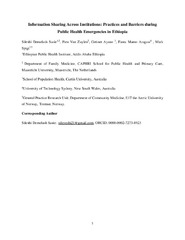| dc.description.abstract | Background - Rapid, integrated information exchange between stakeholders is critical for effective emergency preparedness and response. However, many low- and middle-income countries face barriers to seamless data sharing. While information accessibility is recognized as important for evidence-based decision-making and resource allocation in Ethiopia, factors influencing current health information sharing practices among stakeholders involved in public health emergency management programs are unclear. This study aims to examine multi-sectoral stakeholders' perspectives and experiences with health data sharing during emergencies in Ethiopia, to identify opportunities and challenges influencing practices to strengthen the national public health emergency response system.<p>
<p>Methods - A mixed-methods study was conducted between June and August 2023, involving a survey of 169 stakeholders actively involved in PHEM programs in Ethiopia as well as 23 in-depth interviews with key informants in senior leadership or advisory roles. The data was analyzed using descriptive statistics in SPSS and thematic analysis of qualitative transcripts.<p>
<p>Results - During emergencies, it was observed that data sharing between different entities occurred. Quantitative findings showed the predominant types of health data shared between stakeholders during emergencies included hospital data (109, 64.5 %), clinical case information, and laboratory results. Challenges limiting effective coordination included issues like limited functionality of digital health systems (75, 44 %), incompatible data formats (13, 34 %), and financial constraints (83, 49 %) and and socio-cultural barriers constrain current practices in Ethiopia. Qualitative interviews identified five themes around risk communication and inclusive alert systems. Experts emphasized tailored, multichannel outreach but noted infrastructure gaps and digital divides currently limit poorer communities' engagement.<p>
<p>Conclusion - While collaborative health information exchange during emergencies is recognized as important, systemic, financial, and socio-cultural barriers constrain current practices in Ethiopia. Targeted strategies including capacity building, investment in integrated data infrastructure, economic optimization through innovative financing models, trust-based relationship development, and locally relevant communication channels informed by stakeholder perspectives can optimize information accessibility, coordination, quality, and equity of healthcare services during public health emergencies. | en_US |


 English
English norsk
norsk
